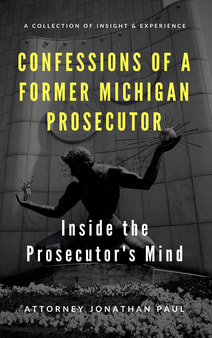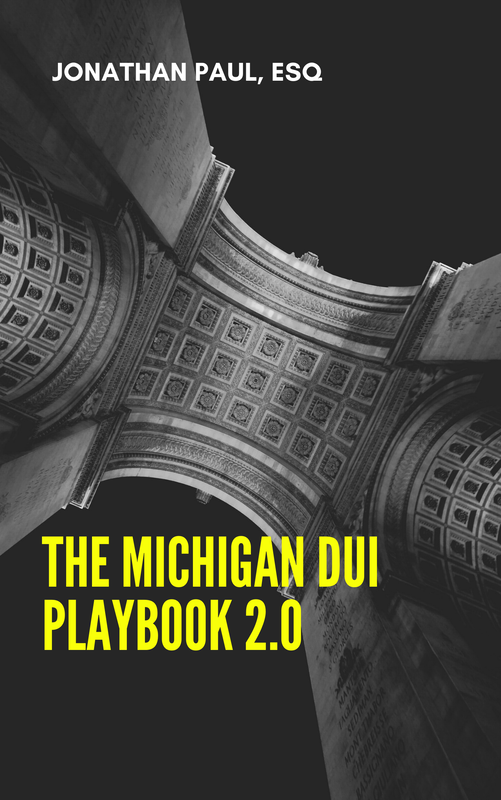|
As a former prosecutor I used to think field sobriety tests were a golden ticket to conviction. Along with the chemical tests, I had my police officer administering a number of super reliable tests and the results were typically favorable to prosecution. I would look at the police room and boom, boom, boom, I had the defendant sinking his/her own case. It wasn't until a few skilled defense lawyers began taking apart these tests that I soon realized they were not as reliable as I once thought.
In Michigan a witness, typically a police officer is allowed to testify to Standardized Field Sobriety Tests (SFST) results and how they relate to impairment if the witness is qualified by knowledge, skill, experience, training, or education. The law specifically states that the Horizontal Gaze Nystagmus (HGN) is admissible under this provision by an officer trained in how to perform the test. In Michigan “Standardized Field Sobriety Test” means one of the standardized tests validated by the National Highway Traffic Safety Administration (NHTSA). A field sobriety test is considered a SFST under this section if it is administered in substantial compliance with the standards prescribed by NHTSA. In simple terms if the police officer is qualified and follows the rules then the evidence can be introduced to the trier of fact or at a evidence hearing. The problem for many people charged is their attorney simply reads the police report and doesn't look into if these tests were done correctly. A cop is NOT going to say they did them wrong in the report - it takes watching the video and listening to the instructions to confirm compliance. Based on my experience as a prosecutor, I know that the prosecutor has not watched the video or firmed up these tests; they just assume they are done correctly. This means if I look further into the issue and spot problems, they WILL NOT be prepared to respond at a hearing or trial, and I have a good shot at making a statement in front of a jury or judge and hopefully discredit these tests. According to a State of Michigan law enforcement memo, the SFSTs are designed as divided attention or psychophysical tests which involve requiring the subject to concentrate on both mental and physical tasks at the same time. These tests are designed to mimic the different abilities and tasks involved in operating a motor vehicle. These include information processing, short-term memory, judgment and decision making, balance, steady and sure reactions, clear vision, small muscle control and coordination of limbs. As a criminal attorney, I am only looking for the BIG THREE: HGN, Walk & Turn and One Leg Stand, because any other test is not standardized and a fiction of the officer's imagination. An officer can just as easily as my client to recite the Detroit Tigers lineup as he can the alphabet - I am going to discredit anything outside of the BIG THREE right away. According to various studies, the HGN is only 77 percent accurate, the Walk and Turn is 68 percent accurate and the One Leg Stand is only 65 percent accurate. As a prosecutor, I would quickly glance at the officer's narrative and just assume "LOOKS GOOD" and move on. As a criminal defense lawyer, I dig into the details and test the officer narrative to the video/audio. Even a small difference between report and video could mean putting the officer in a position of trying to make his report/narrative more favorable and really discredit the whole process. We get the benefit of the doubt on the things we can't see and hear if what we can see and hear is not 100 percent accurate, and it's so important to make a big stink about it, because a jury doesn't know any better. The first test is always the most fishy - the HGN, because there is no video or audio of what the officer is actually observing on my client since it's his eyes - I am looking for proper or improper instructions and if I can see how the officer is actually administering the tests. If he does it by the book, I am hoping that his credibility is put into question on another test, which I can see better such as the one leg stand or walk & turn, so I can argue that it simply taints all the tests. According to the officer training manual here are the proper instructions: 1)Please remove your glasses (if worn). 2)Put your feet together, hands at your side. Keep your head still and follow this stimulus with your eyes only. 3)Keep looking at the stimulus until the test is over. 4)Do not move your head. 5)Do you understand the instructions? The officer will then position the stimulus 12-15 inches from the suspect’s nose and slightly above eye level. He or she will first check to see if both pupils are equal in size (if they aren’t, this may indicate a head injury). The officer will then make sure the eyes are able to track together (called equal tracking) across the suspect’s entire field of vision. Here the officer is looking to see if the eyes track the stimulus together or if one eye lags behind the other (this would indicate medical disorder, injury or blindness). After this is done, the officer continues with the test as listed below: The officer is now looking for the three clues in each eye, so 6 total clues. 1) The Lack of Smooth Pursuit –the eyes can be observed to jerk or bounce as they follow a smoothly moving stimulus, such as a finger or penlight. The eyes of an unimpaired person will follow smoothly, i.e., a windshield wiper gliding across a wet windshield; whereas the eyes of an impaired person will follow in a jerking manner, i.e., a windshield wiper moving across a dry windshield. a.Instruct the subject to hold their head still and to follow the stimulus with their eyes only. b.Move the stimulus smoothly, all the way to the subject’s left, then all the way to the right, then back again all the way to the left, then once again all the way back to the right. c.While the eye is moving, examine it for evidence of a lack of smooth pursuit. d.Each eye counts as one clue for scoring purposes. 2) Distinct and Sustained Nystagmus at Maximum Deviation –distinct and sustained nystagmus is observed when the eye is held at maximum deviation for a minimum of four seconds. People’s eyes exhibit a slight jerking at maximum deviation even when unimpaired, but this jerking will not last more than a few seconds. In alcohol-impaired individuals, the jerking is larger, more pronounced, sustained for more than four seconds, and easily observable. Nystagmus at maximum deviation is observed when the eye is moved to the point where there is no longer any white left in the side of the eye. The nystagmus can be observed to act in a back and forth “popping” motion. a.Position the stimulus as before. b.Move the stimulus all the way to the subject’s left side and hold it there so that the subject’s eye is turned as far to the side as possible. c.Hold the eye at that position for a minimum of 4 seconds to check carefully for any jerking that may be present. d.Then move the stimulus all the way to the subject’s right side and hold it there for a minimum of 4 seconds checking again for any jerking that may be present. e.Repeat both steps b and d (check each eye twice). f.A definite, strong jerking must be seen; a slightly or barely visible tremor is not sufficient enough to count as a clue. g.Each eye counts as one clue for scoring purposes. 3) Onset of Nystagmus Prior to 45 Degrees –the point at which the officer first observes nystagmus or jerkingin the eye. If the jerking begins prior to 45 degrees (typically when the stimulus is aligned with the subject’s shoulder),recent studies have shown that the jerking corresponds with a 0.08-plus BAC. The higher the degree of impairment, the sooner the nystagmus will be observable. a.Position the stimulus as before. b.Slowly move the stimulus to the subject’s left side, carefully watching the eye for the first sign of jerking. c.When you think that you see the eye jerk, stop moving the stimulus and hold it still. d.Make sure to verify that the eye is in fact jerking. e.Once you have established that you have located the point of onset, estimate the angle. f.Repeat this procedure on the subject’s right eye. g.Repeat both steps b and f (check each eye twice). h.Each eye counts as one clue for scoring purposes. Next up is the Walk and Turn - officer is looking for 8 clues. Here are the instructions, which I am looking for compliance or non-compliance. 1)Put your left foot on the line, then your right foot on the line ahead of your left. Keep your arms at your side. (Demonstrate) 2)Do not start until I tell you to do so. 3)Do you understand? (Officer must receive an affirmative response) 4)When I tell you to begin, take heel-to-toe steps on the line. (Demonstrate) To turn around, keep one foot on the line and return nine steps. 5)When you turn on the ninth step, keep your front foot on the line and turn taking several small steps with the other foot. (Demonstrate) Take heel-to-toe steps back down the line. 6)Keep your arms at your side at all times, watch your feet, and count each step out loud. Once walking begins, do not stop until you’ve completed the test. 7)Do you understand the instructions? 8)You may begin. 9)If suspect doesn’t understand some part of the instructions, officer should repeat only that part which suspect does not understand. Here are the 8 clues the officer is looking for during the test. 1)Can’t balance during instructions 2)Starts too soon Walking Stage clues: 3)Stops while walking 4)Doesn’t touch heel-to-toe 5)Steps off line 6)Uses arms for balance 7)Loses balance on turn or turns incorrectly 8)Takes the wrong number of steps Officer will be quick to point out which clues he observed, but it's important to point out what he didn't observe. Let's say the officer lists 3-4 of them, well that means you didn't see the other 4-5, which means something. Finally, we have the one-leg-stand - here are the proper instructions: 1)Stand with your feet together and your arms at your side. (Demonstrate) 2)Maintain position until told otherwise. 3)When I tell you to, I want you to raise one leg (either leg) approximately six inches off the ground, foot pointed out, both legs straight, and look at the elevated foot. Count out loud in the following manner: 1001, 1002, 1003, and so on, until told to stop. 4)Do you understand the instructions? 5)You may begin the test. The timing is very critical during this test. The original research has shown that many impaired subjects are able to stand on one leg for up to 25 seconds but that few can do so for 30 seconds or more. The One-Leg-Stand is divided into two phases: 1) Instruction Stage and 2) Balance and Counting Stage. During the Instruction Stage, the subject must stand with their feet together, keep their arms at their sides, and listen to the instructions. During the Balance and Counting Stage, the subject must perform and complete the exercise as instructed. There are 4 clues that an officer is looking for during the OLS exercise. They are as follows: 1)Sways while balancing 2)Uses arms for balance 3)Hops 4)Puts foot down Same as the walk and turn, if the officer points out clues he observed, it is important to point out what he didn't see. These field sobriety tests are so ripe for attack by a defense attorney, but it takes some extra work. Field sobriety test issues can be used to challenge an arrest or can be used to help argue a close call BAC case. A chemical test result can be presumed to be what the driver would have registered while driving, but that assumption is not required. If I have a 0.09 BAC an hour later, but the field sobriety tests are actually pretty good, I can argue the deviation, plus timing, plus rising blood that my client wasn't above the limit while driving. I can also use the field sobriety tests to challenge an arrest, especially if there is no PBT result over the limit. The possibilities are endless, you just need to be prepared to look deeper into the issue. One of the most common field sobriety tests requested by police officers in Michigan is the NGN test. Nystagmus is an involuntary twitching of the eyes. When an officer checks your eyes, he is looking for this switching. The officer is looking for distinct Nystagmus at the maximum deviation, a lack of smooth pursuit and the onset of the Nystagmus prior to 45 degrees. The proper methods for administering the HGN test is laid out in detail in the National Highway Traffic Safety Administration (NHTSA) manual.
Along with best one of the most popular tests offered, many officers and prosecutors believe this test to be the holy grail of field sobriety tests. While the test does have some scientific importance, the test is only reliable if conducted properly. When I review the police reports and videos in a DUI case, I am looking to make sure the officer followed all of the proper instructions and all precautions were taken to have a fair test for my client. The test begins with the officer instructing the client to put their feet together, and keep their hands to their side. The officer will then instruct the client follow a finger, pen or other device with your eyes, and making sure to keep your head from moving. It’s important to make sure that the officer has asked the client about contact lenses, and any other medical conditions that might be relevant. Before examining your eyes for the three above factors, the officer should be checking for equal tracking and to make sure your pupils are of the same size; failure to do so, and failure to properly ask about contact lenses could deem the results unreliable. The officer checks for equal tracking by starting at the nose, and going right then back to the center then left. Without this initial check, the rest of the exam is worthless. Once the officer has conducted this trial run, he is now looking for smooth pursuit, and looking to see if there is involuntary jerking of the eyes as the object goes from side to side; this is supposed to be two full passes. The officer then looks for Nystagmus at maximum deviation meaning that there is no white visible at the outside of the eye; it requires the officer to hold your eye at maximum deviation for at least 4 seconds, or the results could be unreliable. Finally, the officer will now look for onset of Nystagmus prior to 45 degrees, and vertical Nystagmus. The first requires the officer to bring the eye out from the middle slowly, and to look for the angle of the onset to see if it’s prior to 45 degrees. The second requires the officer to move your eye vertically, and to evaluate the onset of Nystagmus. Failure to follow ANY of these vital instructions could cause Nystagmus, which would other not be present, and will give a false result. The officer’s goal is to find Nystagmus, which in his training tells him that the driver is intoxicated or impaired, which helps prosecute the case. It’s quite rare that the dash cam video provides a full account of this test to ensure that the proper technique and instructions were provided When I look at the evidence in a DUI case, I carefully evaluate any information available to see if the HGN test was done properly. If there is no video then I am going to cross-examine the officer on all of the instructions which are laid out in his training manual, and to make sure he followed it. The officer may or may not have actually followed it, but usually if an officer is not telling the truth, something will pop up during a carefully tailored cross-examination. Usually the most fruitful result of this cross-examination is evidence that my client was facing headlights or traffic, which is now allowed per the training manual for a proper HGN test. Putting the HGN test in question may not be the smoking gun to a not guilty verdict, but it can be a further minor victory when it comes to the officer’s credibility and attention to detail, which puts other parts of the case into question. When a client is pulled over by the police or investigated for a DUI at the scene of accident, the police are now in evidence gathering mode. They are looking for evidence of operation; once they have that, they are then looking for evidence of “being drunk”. This second bucket of evidence comes from the preliminary breath tests, officer observations, statements by the defendant, and field sobriety tests.
A lot of attorneys overlook field sobriety tests, and focus on trying to attack the chemical tests. While it is very important to examine all of your defenses with the chemical tests, the field sobriety tests can be extremely fruitful for a motion to suppress based on an illegal arrest, or assist in a defense at trial. When an officer makes the decision to arrest you, it’s a combination of evidence of operation and probable cause that you committed a drunk driving offense. An officer offers up a PBT test along with numerous field sobriety tests; most people agree to both, which is a mistake. I’ve already discussed how to beat, and use the PBT in your favor, but field sobriety tests can also be declined. Taking a series of field sobriety tests is very unlikely to help your case. The tests are usually taken at night, in potentially freezing weather with rain or snow falling, on the side of the road with other cars flying by and pressure from an authority figure. You’re also likely tired and very nervous; it’s like trying to tie your shoes while standing in the middle of a lion’s cage. If you don’t take field sobriety tests, and you decline the PBT, then an officer may not have enough to make a legal arrest. An officer will have to rely on statements about drinking, how you walked, and talked and observations of your eyes, your smells and your demeanor. If you don’t open your mouth or make admissions then the prosecutor has a thin case for showing a valid arrest. It’s very possible to move for suppression under these circumstances. If my client took field sobriety tests, it’s likely that they “failed” enough to justify an arrest; if a client happened to do very well on the tests then they can help in the argument that the officer lacked probable cause to arrest you, especially if there was not a PBT over the legal limit. Field sobriety tests can also assist at trial. Each test has a set of specific instructions. If an officer fails to read those instructions properly then the test results should be thrown out. If an officer misrepresents how my client performed in his police report, because the video shows the client doing better than documented, it could hurt the officer’s credibility on the entire case. An officer is trained by the National Highway Traffic Safety Administration, and these standards are available to the public. I use the same manual to attack the officer’s administration of the tests, and their selection of those tests. For example, an officer is trained that there are only three field sobriety tests that have been deemed scientifically reliable to detect intoxication/impairment. Horizontal Gaze Nystagmus (HGN) is one of three standard field sobriety exercises conducted by law enforcement. This test looks for involuntary jerking of your eyes as you gaze toward the sides. The other two tests are the walk-and-turn and the one-leg stand. Any test outside of these three should NOT be used. If an officer conducts anything else then they are conducting themselves outside of their training, and it opens the door for an attack on multiple fronts. Finally, if we’re working with BAC levels that straddle the 0.08 or 0.17 lines for different charges, a strong performance on the field sobriety tests can sway a jury to go with our argument that the BAC reading is inflated, and not accurate as to what it was when my client was driving the car. Here’s an example. My client is charged with an OWI. He is stopped at 2 am by the police. My client refuses the PBT, but takes field sobriety tests, which he does well on. The officer admits to him passing most of the tests, and the video backs this up, and even discredits some of the officers observations as being too bearish. The client has a 0.10 BAC at 3 am. At this point we have the opportunity to argue rising blood. The theory goes: look how well the client did on the field sobriety tests - that doesn’t look like someone over the legal limit. Yes he blew a 0.10 an hour later, but he had just finished drinks before getting in his car, and when driving he was below 0.08, and it only rose to 0.10 after time has passed. This technique requires some well planned cross-examination of the police officers, and potentially the Michigan State Police representative or an expert witness brought in by the defense. |
Click to Email Me Categories
All
|
Ann Arbor Office LocationPlymouth Office Location |
Representing DUI Clients in MichiganRepresenting clients charged with a DUI in Ann Arbor, Canton, Brighton, Howell, Saline, Adrian, Taylor, Plymouth, Northville, Westland, Ypsilanti, Pittsfield Towsnhip, Warren, Sterling Heights, Farmington, Pontiac, Romulus, Lansing, Novi, South Lyon, Southfield, Birmingham, Bloomfield Hills, Royal Oak, Troy, Rochester, Jackson, East Lansing, Garden City, Livonia, Dearborn, Detroit, St Clair Shores, Hazel Park, Ferndale, Madison Heights, Waterford, Milford, Shelby Township Clarkston, Oak Park, Berkley, Fraser, Sterling Heights, Clinton Township and others throughout Washtenaw, Wayne, Monroe, Jackson, Genesee, Macomb, Ingham, Lenawee, Livingston and Oakland County.
|








